The Golden Age of
Cartoons:
Cartoons for
Victory
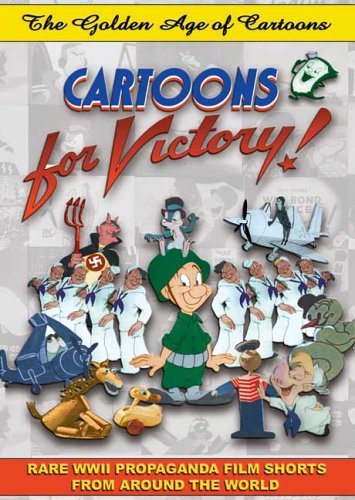
(Thunderbean Animation/Mackinac Media
MM0035D)
Reviewed
on May 23, 2006
The folks at Thunderbean Animation offer
modern-day viewers a comprehensive survey of the animated
films--made for entertainment, propaganda and training
purposes--that were produced and released during the Second
World War. This collection comprises 20 such films; most of
which were produced here in the U.S. by established Hollywood
animation studios like Warner Bros., Walter Lantz and UPA.
Also included are a handful of animated films from Great
Britain, Czechoslovakia, Occupied France and Nazi Germany.
These rare foreign cartoons hold special importance because
they present viewers with different perspectives of the war.
Cartoons like Revolt of the Toys and Bury the
Axis are of particular interest because they
utilize, respectively, a combination of live-action and
animation and stop-motion puppets instead of traditional cel
animation.
All of the cartoons presented in this compilation
were produced and distributed for viewing by contemporary
audiences; and no consideration appears to have been given to
their preservation beyond the period in which they were made.
Transfers have been made from the best available 16mm and 35mm
materials. In most cases the original negatives were destroyed
or have been lost in the intervening years. Many films are
seen here in their only surviving prints. Steven Stanchfield
and his associates have done an admirable job in transferring
this material to DVD and have refrained from utilizing DVNR,
which more often than not makes bad prints look even worse.
While the majority of the prints have a fair number of
scratches, and even some unfortunate splices which momentarily
interrupt the film continuity; the historical importance of
these cartoons far outweighs any technical
shortcomings.
As in previous releases from Mackinac Media, the
packaging design and interactive menus are top-notch. Each of
the menu screens is accompanied by a music cue taken from one
of the cartoons contained on the DVD. In this respect they
seem to have taken their cue from Disney's "Treasures" series
of animation DVD's. This time around Mackinac appears to have
worked out the technical bugs that were inherent in their
previous DVD's Popeye: Classics from the Fleischer
Studio and Attack of the 30's Characters. I was
able to play the disc (the regular program and the bonus
features) on both the DVD-ROM drive on my PC and on my regular
DVD player with no difficulty whatsoever.
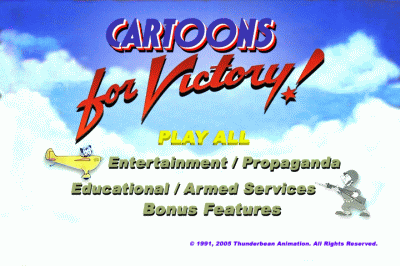
Viewers have the option of playing the cartoons
straight through or selecting them individually from two
categories: Entertainment/Propaganda and
Educational/Armed Services. In the former category the
only cartoon familiar to most animation aficionados is the
Bugs Bunny Bond Rally (Warner Bros.,
1943), in which Bugs (joined at the end by Porky Pig and the
earlier, rotund version of Elmer Fudd) gives a rousing
rendition of Irving Berlin's "Any Bonds Today?" The cartoon is
presented complete and uncensored; and includes Bugs'
impersonation of Al Jolson in Blackface that was cut from the
"Toonheads: The Lost Cartoons" segment in Volume 1 of the
Looney Tunes Golden Collection. The remaining cartoons, with
the exception of the "Private SNAFU" entries and "The Return
of Mr. Hook", are presented on DVD for the first time in this
compilation.
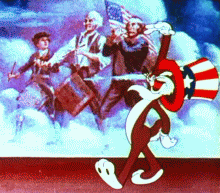
Hans
Fisherkoessen's Der Schneemann (Nazi Germany, 1943)
is a delightful and charming tale of a snowman that, after
coming to life and frolicking in the snow, hibernates in a
kitchen icebox so that he can romp in the fields during the
summer months. In the end, however, he melts away and his
carrot nose is eaten by a rabbit. The animation in this short
is wonderfully fluid and boasts some impressive background
work. In fact, the house that the snowman visits has a
striking 3-dimensional quality to it; suggesting that it was
either rotoscoped from "live" footage or photographed using a
tabletop model and animation cel setup--similar to the one
employed by the Fleischer Studio for their 2-reel Popeye
"specials".
In the aforementioned Bury the
Axis (Great Britain/Lou Bunin, 1943)
Hitler, Mussolini and Hirohito are portrayed by stop-motion
puppets. The cartoon chronicles Hitler's birth, brief
childhood and eventual rise to power. The visual effect of the
stop-motion animation in this cartoon is eerily reminiscent of
the later Rankin-Bass holiday specials produced for
television; so much so that I half-expected caricatures of
Fred Astaire and Burl Ives to pop up and start singing
"Deutschland uber alles". Bunin was actually
American. He was responsible for Alice au Pays des
Merveilles, a stop-action version of Alice
in Wonderland that tried to compete with the Disney
version. The rumor is that Disney, with its own project in
mind, sabotaged the release of Bunin's version in the U.S.
Nimbus
Libéré (Vichy France, 1943) is in French and,
unfortunately, has no subtitles; which will make it difficult
for many American viewers who don't speak French to understand
what is going on in the cartoon. According to the liner notes
the American forces, who are trying to liberate Occupied
France, are represented by such popular cartoon characters as
Mickey Mouse, Donald Duck, Goofy, Felix the Cat and Popeye the
Sailor. The other characters in this short include a
provincial French family, the patriarch of which resembles a
Bourgeois version of Farmer Al Falfa; and a decidedly
"Jewish"-looking radio announcer who is broadcasting via
short-wave from London. At the conclusion of this bizarre
cartoon the American forces end up bombing the citizens they
were attempting to rescue. The animation here is by the French
comic artist Cal, and his renderings of Donald Duck and Popeye
the Sailor are dead-on. Viewers take note of the cockpit of
Popeye's bomber plane; apparently he enjoys a little nip of
whisky in addition to his daily spinach!
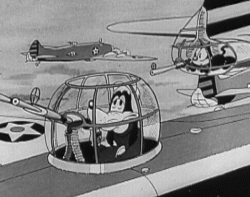
In Hermína Týrlová's Revolt of the
Toys (Czechoslovakia, 1945) a Nazi SS
Officer receives his come-uppance from a group of toys who
magically come to life. The blend of live-action and animation
here is well-done. Týrlová', one of the first Czech women
animators, worked for Degeto Film, a German firm, during the
German occupation of Czechoslovakia. After the war she
produced films with Kratky Film Praha. A filmography of her
works is available at www.imdb.com/name/nm0879624.
Der Springmann Und Der
SS (Jiri Trnka/Czechoslovakia, 1946; Original
Czech title: Pérák a
SS) is the tale of a local chimney sweep who,
by donning a black, ninja-like costume and wearing a pair of
springs removed from a necking couples’ living room love-seat,
takes on the local Gestapo. There is a wonderful scene near
the end of the cartoon where very realistic-looking
(rotoscoped?) black smoke is billowing and filling most of the
screen.
Cap’n Cub
(alternately known as "Cap'n Cub Scraps the Japs", Ted
Eshbaugh, 1945) is described as one of the strangest cartoons
produced during WWII. Perhaps, but it has some impressive
dogfight animation and a peppy music score that is at times
reminiscent of the tunes of Raymond Scott. Cap'n Cub witnesses
a review of all divisions of the animal fighting forces; and
then decides that more planes are needed to win the war. An
ersatz version of Scott's "Powerhouse" is heard on the
soundtrack during a bizarre aircraft plant sequence. The
planes no sooner leave their hangar when they encounter a
single Japanese fighter plane; the pilot of which is portrayed
(in stereotypical fashion) by a monkey. The enemy is
ultimately defeated and the allied planes head off into the
sunset (depicted as the setting sun of the Japanese flag) with
Cap'n Cub in the lead. The highlight of this cartoon, for me,
was a machine-gun toting kangaroo--whose offspring also fires
at the enemy aircraft with great gusto. The version of this
cartoon seen here appears to have edited from two different
sources--at one point in the cartoon, when Cap'n Cub's plane
descends onto the parade grounds, the film briefly changes
from color to black and white.
Only a small number of
Eshbaugh’s films, including Cap’n Cub, are known to be
extant. Eshbaugh produced an early animated version of L.
Frank Baum's The Wizard of Oz (1933, shot in 3-Strip
Technicolor and part of a proposed "Oz" series that never
developed), Goofy Goat
(1933, re-titled "Goofy Goat Antics" by Official Films for
home movie and TV distribution) and The Snow Man (1933, estimated) in
California—according to Tim Cohea of Golden Age
Cartoons. The Snow Man is listed in the Big Cartoon
DataBase as actually
having been produced in Canada, however; and this cartoon had
been released earlier by the Van Beuren Studio as The Snowman . It is not clear if these
are two different cartoons; or if The Snow Man is
simply a re-issue of The Snowman by the Film
Laboratories of Canada. The 3-Strip Technicolor segments of
the “Oz” cartoon, according to Steven Stanchfield, were
processed in Canada in spite of Walt Disney’s exclusive
contract with the Technicolor Company. In 1934 Eshbaugh
migrated to New York where he did a brief stint at the Van
Beuren studio. It was there that he and Burt Gillett (with
whom he—and most everyone else—reportedly did not get along)
produced what is probably the best-known of his films, The Sunshine
Makers (1935). Eshbaugh directed two other
cartoons at Van Beuren before leaving, Pastry Town
Wedding (1934) and Japanese Lanterns (1935). Eshbaugh
contracted with different companies in the production of
commercial animated films after his departure from Van Beuren.
A series of brief animated vignettes that Eshbaugh produced
for Wonder Bread and Hostess Cakes--for exhibition at the 1939
World Fair--is featured on the Thunderbean/Mackinac
compilation, Cult-Toons.
The educational and training
films which make up the bulk of this collection are
interesting to watch, if only to see what the major cartoon
studios could accomplish (or get away with) when not
restricted by normal Hollywood conventions. All of the Private Snafu
and at least two of the Mr. Hook cartoons
produced by Warner Bros (the first was produced by Walter
Lantz) contained in this compilation have been available
before--either on bootleg and "official" VHS videotapes and
DVD's, or as streaming videos on the internet. Spies and
The Return of Mr.
Hook can be found as bonus features on Volume 3
of the Looney Tunes Golden
Collection.
The Private SNAFU (a military
acronym for "Situation Normal: All F***ed Up") series was
produced by Leon Schlesinger's cartoon studio at Warner Bros.
for the Army-Navy Screen Magazine. There are 26
episodes in this series (including two that were never
released) that were produced between 1942 and 1945. These were
filmed in B&W and 35mm but were distributed to military
units at home and overseas in 16mm format--because the reduced
film-width made shipment of the cartoons less cumbersome, and
because most military units could be equipped with
lightweight, portable 16mm film projectors.
Private SNAFU was your average U.S. soldier, who
was depicted in each film as a constant screw-up who got
himself in hot water for not following standard procedures.
The character was created by Phil Eastman and Theodore "Ted"
Geisel, better known to baby-boomers as "Dr. Seuss". Geisel
wrote many of the initial episodes in the series. A number of
these were written in verse. Phil Eastman had a very
interesting career. He was active in the bitter Disney strike
-- so, for that matter, was Hank Ketcham. Eastman got
blacklisted during the McCarthy era and worked clandestinely
in the back rooms of Shamus Culhane's New York studio --
ironically, doing copy for Navy recruiting commercials!
Eastman got the last laugh on the Red-baiters... he changed
his name slightly to P.D. Eastman and became a famed
children's author and illustrator. His works include Are
You My Mother, Go Dog Go!, Sam and the
Firefly, The Best Nest and Are You My Mother?
Several of his books won awards.
According to
Chuck Jones, storyboards for the Private SNAFU cartoons had to
be approved for content by the Pentagon. Individual episodes
were directed by Chuck Jones, Robert Clampett, Friz Freleng
and Frank Tashlin. Carl Stalling and Treg Brown each
contributed their familiar brand of music and sound effects;
and voice talent was provided by Mel Blanc, along with Bea
Benederet and Robert C. Bruce (often as a
narrator.)
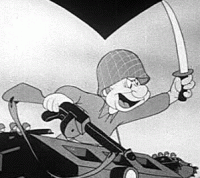
One of the best entries in the series, Spies (1943)
was directed by Jones and features typical "Seuss-ian" rhyming
verse. Robert Canonn and Ken Harris contribute superb
animation SNAFU inadvertently tips off Axis agents about his
impending assignment to Africa, winds up getting killed and
gets sent to Hell. Sexual and Swastika gags abound in this
episode.
Booby Traps
(1944) was directed by Robert Clampett and features what
is possibly the first appearance of the "exploding piano" gag
(set to the melody of "Those Endearing Young Charms") in a
Warner Bros. cartoon that would later turn up in Ballot Box
Bunny, Show Biz Bugs
and Rushing Roulette
(the only Road-Runner cartoon directed by Robert
McKimson!) That gag, according to Eric Goldberg, actually has
its origins in one of the Van Beuren-produced "Little King"
cartoons from the 1930's. Apparently Clampett was very much
influenced by the early cartoons produced in New York by Van
Beuren, Paul Terry and the Fleischer Bros. Subtlety was never
a feature of these cartoons, which offered servicemen a fair
amount of gratuitous double-entendres and profanity,
and this particular cartoon is no exception--witness as SNAFU
encounters a pair of "booby traps"!
In The Chow Hound
(1944), also directed by Jones, a bull
selflessly gives his all (literally) for the war
effort--allowing himself to be "processed" into steaks,
hamburgers, roast beef hash, creamed chipped beef, etc. so
that soldiers like SNAFU can be well-fed. SNAFU,
unfortunately, turns out to be a "food hoarder" whose eyes are
bigger than his stomach; and as a result he ends up wasting
most of the meat he has snuck from the chow line. The print
used for this compilation contains a bad splice--at the point
where the phantom bull charges at SNAFU in retaliation and
head-butts him into oblivion.
Both A Lecture On
Camouflage (1944) and Censored
(1945)—directed, respectively, by Jones and
Tashlin—offered servicemen a generous serving of “cheesecake”
while teaching the dos and don’ts of concealing one’s position
and sending correspondence to the loved ones at home. An
unfortunate bad splice occurs in the latter cartoon, during
the scene featuring SNAFU’s topless girlfriend. Whatever else
was meant to be shown in that scene, we may never
know!
The four Mr. Hook cartoons contained on this DVD
are from rare 16mm prints that were saved by an Army
cameraman. This series was the U.S. Navy’s answer to Private
SNAFU, but the premise behind each entry had a singular
purpose—to get servicemen to purchase war bonds. The character
was designed by Hank Ketcham (of “Dennis the Menace” fame).
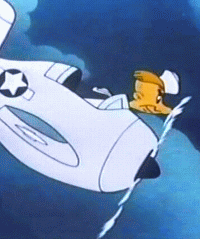
The first cartoon in the series, Take Heed, Mr.
Tojo (1943), was produced by the Walter Lantz
Studio and directed by Jimmy “Shamus” Culhane (who had
previously animated for Disney and Warner Bros.) Darrell
Calker provided the jazzy music score; and the voice of the
Hook character heard here—although this has yet to be
authenticated—is reportedly by George O’Hanlon (who later
voiced George Jetson on Hanna-Barbera’s The
Jetsons). The animation in this cartoon is
quite good, although—as commentator Jerry Beck points
out—clean-up drawings were not always done before the
animation was inked and painted onto cels, as a time and
cost-saving measure. Why further cartoons in this series were
not produced by Lantz is not clear, although it could have
been that the workload at his studio was already too great
(Lantz had lost a number of his staff to the draft during the
war.) In this cartoon Mr. Hook describes his role in the war
to his son though a series of flashbacks.
Besides being the first cartoon in the Mr. Hook series, this
was the only entry made in Technicolor. The other three were
produced in black and white.
The next three cartoons in the series were taken
over by the Leon Schlesinger Studio at Warner Brothers. As in
the Private SNAFU series, Carl Stalling provided music and Mel
Blanc and Bea Benederet most of the voices (with the exception
of Hook himself—this time voiced by Arthur “Dagwood” Lake of
the “Blondie” radio and TV series). McKimson, Jones and
Clampett each took a turn with the character. In his
commentary for these three Hook cartoons, John Kricfalusi
conducts what he calls a “controlled” experiment in analyzing
each director’s style—since each of them is dealing with an
unfamiliar character.
The Good Egg
(Chuck Jones, 1945) shows Hook being pestered by his good
and bad alter egos about what to do with his savings bonds.
The fluid poses and extremes in this cartoon suggest that the
animation was done principally by Robert Cannon, but
unfortunately no animator credit is given.
In Tokyo Woes
(Robert Clampett, 1945) the Japanese propaganda machine is in
full force, trying to dissuade American servicemen from
investing in the war. Rod Scribner’s (?) rubbery animation of
Tokyo Rose (portrayed here as a bobby-soxer, whom we first
encounter sitting on the toilet) is outrageously funny,
despite the overt racist stereotype. Mel Blanc here resurrects
his “Sad Sack” radio character (which used a voice
characterization similar to that of Porky Pig).
Double-entendres abound in this cartoon.
The Return of Mr.
Hook (Robert McKimson, 1945) was intended to
show servicemen all the post-war benefits of saving war bonds.
Mr. Hook comes home, buys some new duds, a new home with
furnishings and marries his sweetheart. The character
animation and the layouts are very well-done here and this
actually was the first cartoon that McKimson ever directed at
Warner Bros. He would not direct his first theatrical cartoon
there until 1946.
The remaining four instructional training films
are extremely rare but are offered in prints that wear their
years lightly.
Both Flight Safety: After the Cut and
Flight Safety: Landing Accidents were produced
in 1946 by United Film Productions, the company that would
eventually become United Productions of America (UPA), and
feature the stylized animation and backgrounds that would
revolutionize the animation industry just a few years later.
It’s a pity that the producers of this DVD didn’t think to
include Chuck Jones’ Hell Bent for Election (1944),
which was one of the first animated cartoons—industrial or
otherwise—produced by the fledgling studio during the war.
Then again, the current running time of this DVD (142 minutes,
including bonus features) may have not have allowed room for
it.
Commandments for Health: Taking Medicine
(1945, attributed to Hugh Harman’s independent studio) is
unique in that it is executed largely in rough storyboard
fashion with a mixture of full and limited animation. The odd
thing about this cartoon is that its main character bears a
striking resemblance to Private SNAFU.
The most impressive (from a
technical standpoint) and entertaining cartoon in this last
group of training films is Camouflage (U.S. Army Air
Forces 1st Motion Picture Unit, 1943). Frank Thomas, one of
the “nine old men” from the Disney Studio, directed this 20
minute film—in which a Jiminy Cricket-like chameleon
demonstrates the proper way to camouflage buildings, aircraft
and personnel to U.S. Army Air Corps pilots. The animation,
done by former staff from many of the top Hollywood studios,
is superb.
The bonus features included as part of this
collection are, unfortunately, the one area in which the
quality is inconsistent with the rest of the DVD.
Spoken commentaries are provided only for the
Private SNAFU and Hook cartoons; and even then there is a fair
amount of duplication—in that more than one commentary is
provided for some cartoons. It’s a shame that no commentaries
were provided for any of the lesser-known cartoons, like
Cap’n Cub, Der Schneemann, or the excellent
Camouflage, as these are deserving of more detailed
analysis. Of the spoken commentaries provided I found those of
Eric Goldberg and Jerry Beck to be the most informative; and
those of John Kricfalusi to be somewhat biased, rather un-PC
(he uses the word "retard" at one point, when commenting on
SNAFU's inability to notice a bevy of scantily-clad women) and
rambling. At one point during one of the Private SNAFU
cartoons, he takes the opportunity to plug his upcoming,
uncensored DVD of newly-produced Ren and Stimpy
cartoons--referring to them as “his own Private SNAFU
cartoons”. Throughout Booby Traps he can be heard lauding Robert
Clampett’s direction (which I, too, admire), while at the same
time lambasting that of Chuck Jones. Although The Good Egg
is admittedly weak, when compared to the other "Mr. Hook"
cartoons, was it really necessary to refer to Jones’
directing style here as “gay”? Kricfalusi would have us
believe that all U.S. servicemen fighting in WW2 were gruff,
horny, loud-mouthed schnooks; who most likely would not have
responded favorably to a cartoon like The Good Egg
because of its so-called effeminate style. This, I feel,
is an unfair assessment; since Jones only directed one cartoon
in the Mr. Hook series, and he was dealing with a character
(created by someone else) with which he probably did not feel
completely at ease. At the same time, however, a number of
Jones’ Private SNAFU cartoons are rife with sexual innuendo
and nudity (particularly in A Lecture on Camouflage),
so Kricfalusi’s assessment in this context appears to be
without justification.
The stills gallery included
with the bonus features offers a look at some rare artwork
produced both here and abroad. Of special interest to cartoon
fans is the inclusion of a transcription from the “Command
Performance” radio program that was broadcast to servicemen
overseas during the war. This particular broadcast focused on
animals in the military; and featured the voices of Mel Blanc,
Arthur Q. Bryan, “Pinto” Colvig and Clarence Nash, all
recreating the cartoon characters with whom they are best
associated (although Colvig portrays his character, Goofy,
here as a draft horse.) This may be the first and only time,
prior to Who Framed Roger
Rabbit that cartoon characters from different
studios ever shared the same stage! I had no trouble accessing
either of these bonus features on my DVD player.
My overall ratings for Cartoons for Victory (using
a four-star system) are thus:
Packaging and Design:
****
Menu Options ****
Visual Quality ***(*) Some
allowance needs to be made due to the rarity of a number of
these cartoons
Sound Quality ****
Bonus Features **** The
“Command Performance” segment is a rare treat!
Commentaries **(**) I
only found some of these to be helpful…
Value for the money
****
Special thanks to Eminovitz for valuable
information on Phil Eastman and other tidbits (and for
pointing out some of my more glaring errors); and to STARFOX
for providing pics.
(This post was edited
by zavkram on Aug 12, 2006, 10:26
PM)








